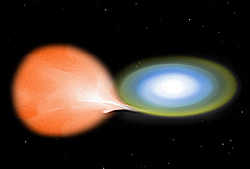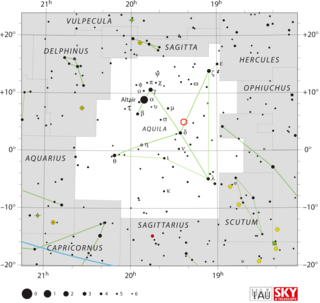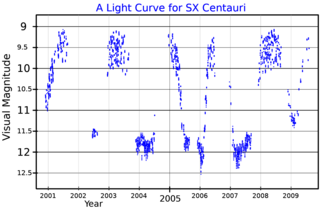
A nova is a transient astronomical event that causes the sudden appearance of a bright, apparently "new" star that slowly fades over weeks or months. Causes of the dramatic appearance of a nova vary, depending on the circumstances of the two progenitor stars. All observed novae involve white dwarfs in close binary systems. The main sub-classes of novae are classical novae, recurrent novae (RNe), and dwarf novae. They are all considered to be cataclysmic variable stars.

Beta Centauri is a triple star system in the southern constellation of Centaurus. It is officially called Hadar. The Bayer designation of Beta Centauri is Latinised from β Centauri, and abbreviated Beta Cen or β Cen. The system's combined apparent visual magnitude of 0.61 makes it the second-brightest object in Centaurus and the eleventh brightest star in the night sky. According to parallax measurements from the astrometric Hipparcos satellite, the distance to this system is about 390 light-years.

DK Lacertae was a nova, which lit up in the constellation Lacerta in 1950. The nova was discovered by Charles Bertaud of the Paris Observatory on a photographic plate taken on 23 January 1950. At the time of its discovery, it had an apparent magnitude of 6.1. DK Lacertae reached peak magnitude 5.0, making it easily visible to the naked eye.

V1494 Aquilae or Nova Aquilae 1999 b was a nova which occurred during 1999 in the constellation Aquila and reached a brightness of magnitude 3.9 on 2 December 1999. making it easily visible to the naked eye. The nova was discovered with 14×100 binoculars by Alfredo Pereira of Cabo da Roca, Portugal at 18:50 UT on 1 December 1999, when it had a visual magnitude of 6.0.

V842 Centauri, also known as Nova Centauri 1986, was a nova which occurred in 1986 in the constellation Centaurus. It was discovered by Robert H. McNaught of Siding Spring Observatory in Australia, on 22 November 1986. At the time of its discovery, it had an apparent magnitude of 5.6. It reached a peak magnitude of 4.6 one and a half days later, making it easily visible to the naked eye.

HD 129116 is a binary star in the northeastern part of Centaurus, east of Menkent. It is also known by its Bayer designation of b Centauri, while HD 129116 is the star's identifier in the Henry Draper catalogue. This object has a blue-white hue and is faintly visible to the naked eye with an apparent visual magnitude of +4.01. It is located at a distance of approximately 325 light years from the Sun based on parallax, and has an absolute magnitude of −1.07.

HD 125823, also known as V761 Centauri or a Centauri, is a variable star in the constellation Centaurus. It is a blue-white star that is visible to the naked eye with a mean apparent visual magnitude of +4.41. The distance to this star is approximately 460 light years based on parallax measurements. It is a member of the Upper Centaurus–Lupus subgroup of the Scorpius–Centaurus association.
HD 113703, also known by the Bayer designation f Centauri, is a multiple star system in the southern constellation of Centaurus. The combined apparent visual magnitude of this system is +4.71, which is sufficient to make it faintly visible to the naked eye. The distance to this system is approximately 400 light years based on parallax measurements. It is a member of the Lower Centaurus Crux subgroup of the Scorpius–Centaurus association.

Omicron1 Centauri is a star in the constellation Centaurus. It is approximately 10,000 light years from Earth.

Omicron2 Centauri is a star in the constellation Centaurus.

V404 Cygni is a microquasar and a binary system in the constellation of Cygnus. It contains a black hole with a mass of about 9 M☉ and an early K giant star companion with a mass slightly smaller than the Sun. The star and the black hole orbit each other every 6.47129 days at fairly close range. Due to their proximity and the intense gravity of the black hole, the companion star loses mass to an accretion disk around the black hole and ultimately to the black hole itself.

V339 Delphini or Nova Delphini 2013 (PNV J20233073+2046041) is a bright nova star in the constellation Delphinus. It was discovered on 14 August 2013 by amateur astronomer Koichi Itagaki in Japan and confirmed by the Liverpool Telescope on La Palma. The nova appeared with a magnitude 6.8 when it was discovered and peaked at magnitude 4.3 on 16 August 2013. A nova is produced by the fusion of accumulated material on the white dwarf nova progenitor acquired from its companion star. The nova system is thus a binary star, and a classical nova. The white dwarf is a carbon-oxygen white dwarf, with an estimated mass of 1.04±0.02 M☉. There is not yet a consensus about what the binay's orbital period is; estimates range from 3.15 hours to 6.43 hours.

KT Eridani was a bright nova in the constellation Eridanus that produced an outburst in 2009. It was the first classical nova ever detected in that constellation. The nova was discovered at 12:52 UT on 25 November 2009 by K. Itagaki at Yamagata, Japan with a 21 cm patrol telescope. At the time of its discovery, it was a magnitude 8.1 object. The discovery occurred after the nova's peak brightness, but the All Sky Automated Survey system had detected the nova on three earlier occasions, allowing a more complete light curve to be produced. The peak magnitude, 5.4, was seen at 15:10 UT on 14 November 2009.

V5856 Sagittarii, also known as Nova Sagittarii 2016 Number 4, was the 4th and brightest nova that occurred in the constellation Sagittarius during 2016. It was discovered by the All Sky Automated Survey for SuperNovae on 25.02 October 2016, at which time it had an apparent visual magnitude of 13.7. It was independently discovered by Yukio Sakurai of Mito, Ibaraki, Japan on 26.38 October 2016, by which time it had reached magnitude 10.4. It reached its peak brightness of magnitude 5.4, making it visible to the naked eye, on 8 November 2016. The nova occurred within a region of the sky monitored by the OGLE microlensing experiment, and that group reported that no star brighter than magnitude 22 was seen at the nova's position prior to its eruption.

BV Centauri is a cataclysmic variable binary star in the constellation Centaurus. It is a dwarf nova, and undergoes rapid increases in brightness that are recurrent with a mean period of 150 days. This period seems to have increased in the last few decades. During quiescence, its visual apparent magnitude is about 13, with variations of a few tenths of magnitude over an orbit due to differences in the star's visible surface area, brightening to a maximum magnitude of 10.7 during outbursts. From its luminosity, it is estimated that the system is about 500 parsecs (1,600 ly) away from Earth. A Gaia parallax of 2.81 mas has been measured, corresponding to about 360 pc.

SX Centauri is a variable star in the constellation Centaurus. An RV Tauri variable, its light curve alternates between deep and shallow minima, varying its apparent magnitude from 9.1 to 12.4. From the period-luminosity relationship, it is estimated to be around 1.6 kpc from Earth. Gaia Data Release 2 gives a parallax of 0.2175 mas, corresponding to distance of about 4,600 pc.

V906 Carinae, also known as Nova Carinae 2018, was a nova in the Milky Way galaxy which appeared in the constellation Carina, near the 5th magnitude star HD 92063. It was discovered on images taken on 20.32 March 2018 by the All Sky Automated Survey for SuperNovae (ASAS-SN] telescope at the Cerro Tololo Inter-American Observatory. The ASAS-SN group assigned the name ASASSN-18fv to the object. The discovery image was saturated, allowing researchers to determine only that the object was brighter than apparent magnitude 10. An earlier image obtained by ASAS-SN on 26.32 March 2018 showed the nova was a magnitude ~10.4 object at that time, and the object was not detected on ASAS-SN images taken on 15.34 March 2018 and earlier.

V392 Persei, also known as Nova Persei 2018, is a bright nova in the constellation Perseus discovered on April 29, 2018. It was previously known as a dwarf nova.

YZ Reticuli, also known as Nova Reticuli 2020 was a naked eye nova in the constellation Reticulum discovered on July 15, 2020. Previously it was known as a VY Sculptoris type object with the designation MGAB-V207.

Nova Cassiopeiae 2021, also known V1405 Cassiopeiae, was a nova in the constellation Cassiopeia. It reached a peak brightness of magnitude 5.449 on May 9, 2021, making it visible to the naked eye. It was discovered by Japanese amateur astronomer Yuji Nakamura of Kameyama, Japan, at 10:10 UT on March 18, 2021. The nova was first seen by Nakamura in four 15 second CCD exposures with a 135mm F/4 lens, when it was at magnitude 9.3. Nothing was seen brighter than magnitude 13.0 with the same equipment in exposures taken at 10:12 UT on March 14, 2021. For the first seven months after discovery, the nova's brightness stayed at a rough plateau, fading and rebrightening at least eight times; it is considered a very slow nova. After the seven month long series of peaks, Nova Cassiopeiae began a linear decline in brightness. This nova has been detected throughout the electromagnetic spectrum, from radio to gamma rays.






















